Gauged Porcelain Tile Panels/Slabs Trends

Gauged porcelain tile panels/slabs (GPTP) are defined as tiles measuring larger than 1 x 1 meter, and are commonly seen on wall and floor applications, both indoors and outdoors.
Photo courtesy of Infinity Surfaces
Gauged porcelain tile panels/slabs (GPTP) are gaining a lot of traction in the tile and stone industries as of late. The large-format materials, which are technically defined as tiles measuring 1 x 1 meter (40 x 40 inches) or larger, have been around for almost 10 years now, but have been creating a lot of buzz in the marketplace over the last handful of years.
Tile manufacturers continue to push boundaries with GPTP, in terms of design and size, crafting porcelain interpretations of everything from natural stone to wallpaper and even personalized pictures. Some panels stand as tall as 12 feet, with thicknesses that range from 1/8 inch (3 mm) to 3/4 inch (20 mm). However, new 3 cm (30 mm) options have been introduced recently to use as pavers for outdoor walkways, patios and driveways. Although GPTP are commonly seen on interior flooring and walling, as well as exterior facades, the innovative material also been utilized to create furniture and other household accessories.
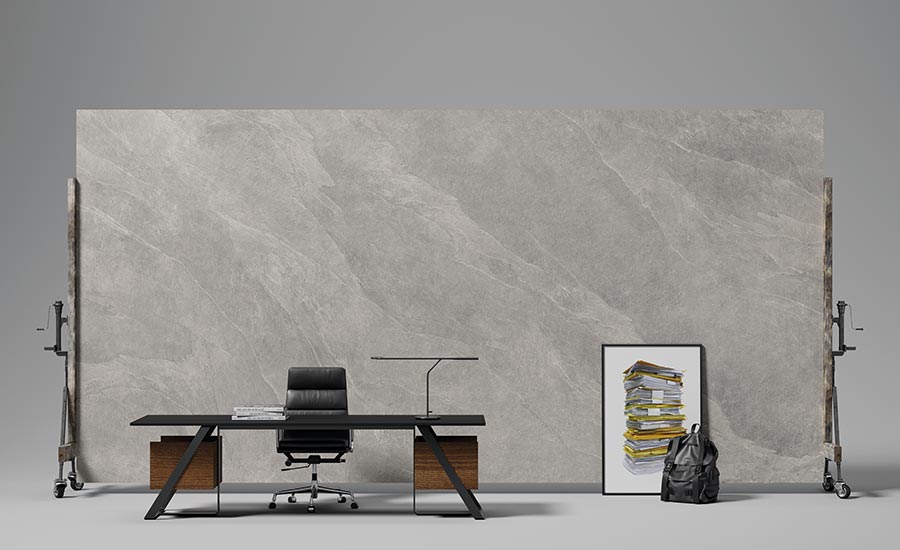
Photo courtesy of Emilgroup
When GPTP was first realized, there were no standards or methods as to how to handle, cut, transport and install the material, so the Tile Council of North America (TCNA) made it their mission to create guidelines for installers, as well as the architecture and design community. In 2017, after more than four years of cross-disciplinary industry collaboration and 4,000 hours of research, the TCNA unveiled two new standards for the materials known as ANSI A137.3, the American National Standard Specifications for Gauged Porcelain Tiles and Gauged Porcelain Tile Panels/Slabs, and its companion, ANSI A108.19, Interior Installation of Gauged Porcelain Tile and Gauged Porcelain Tile Panels/Slabs by the Thin-Bed Method Bonded with Modified Dry-Cement Mortar or Improved Modified Dry-Set Cement Mortar.
“Installers especially were asking for standards to allow for installation practices to be developed based on consistent tile properties,” said Eric Astrachan, TCNA executive director. “Without such, it was feared that problems resulting from an undefined range of products could hinder growth of this market segment.”
ANSI A137.3 is the standard for GPTP, dictating how the panels should be manufactured to meet certain physical properties, while ANSI A108.19 is the standard for the interior installation of GPTP. The standards use the term “gauged” to cover a range of precise thicknesses that can carry different loads and be used in different ways. Two classes of gauged tile products are defined — those for wall applications, from 3.5 to 4.9 mm in thickness, and those for floor applications, from 5 to 6.5 mm in thickness.
We sat down with a wide range of industry professionals — including tile manufacturers, technical representatives and installers — to discuss the current trends they’re seeing in GPTP, their importance in the marketplace and what to expect in the near future.
Design innovation
“Gauged Porcelain tile panels and slabs are increasingly being selected by designers and specifiers for both commercial and high-end residential projects,” said Bart Bettiga, executive director of the National Tile Contractors Association (NTCA). “Often, they are selected where high performance is desired, including wet area applications like showers and steam rooms, as well as commercial and high-end residential bathrooms. The advanced manufacturing processes allow for the slabs to be installed with minimal grout widths, the ability to match and bookmark patterns, and with proper substrate preparation for retrofitting or installing directly over other surface materials.”
Tile manufacturers are also seeing an influx in the request of these materials from architects and designers all over the world. “We continue to show, year after year, double-digit growth in our panel line,” said Noah Chitty, director of technical services at Crossville, who was recently appointed as the chairman of the ISO/TC 189 committee, a global entity that oversees and sets standards for the tile industry. “We have seen this every year for eight straight years. For sure, large panels are starting to be mainstream and have become to be embraced by architects, designers and for residential applications.”
“The promotional activities undertaken by many companies geared towards architects and designers have surely increased the request for these items,” said Michelle Ballarin, director of Florim Stone for the North American market. “Prestigious projects executed using the large panels have demonstrated the capabilities of this material even to the more skeptical. Projects featured in magazines and on the web have also attracted regular customers who now want to get educated and evaluate this new product for their residential projects.”
“The greatest demand comes from the world of architecture, especially for the 6.5-mm-thick slabs,” said Giancarlo Macchioni, marketing and research and development director at Emilgroup. “Interior designers typically choose 12-mm-thick slabs for their projects, but requests from the end consumer are growing.”
“We have noticed that designers and architects are focusing on the 120- x 260-cm format (47- x 102-inch/4- x 8.5-foot), while the larger format, 160 x 320 cm (63 x 126 inches/5 1/4 x 10 1/2 feet), is used primarily for further processing — cut-to-size for making custom items of furniture in response to the requests from clients,” added Vittorio Borelli, CEO of Fincibec Group.
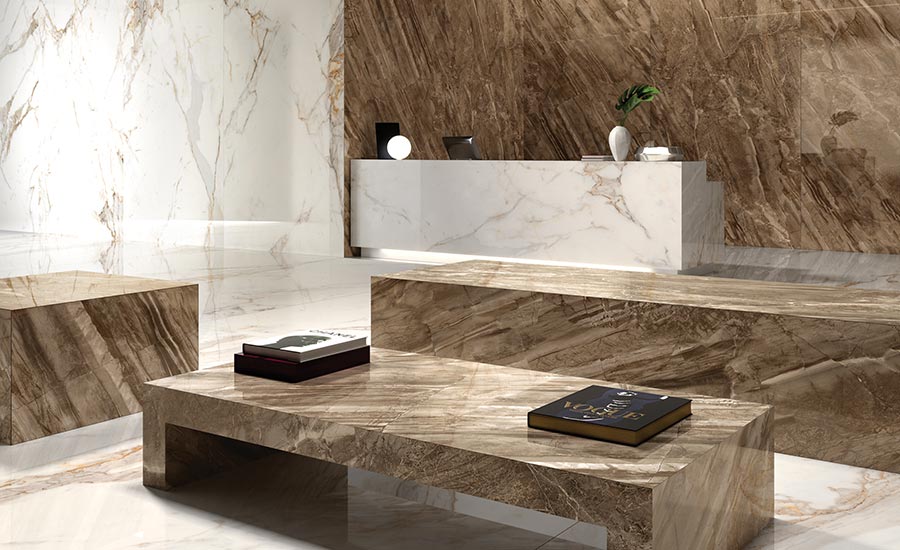
Photo courtesy of Fincibec
When asked about the most popular type of design requested in GPTP, there was no argument that marble looks reign supreme, with industrial-inspired materials trailing closely behind. “In maxi-slabs, it’s above all the marble effect, with both glossy and natural finishes, that attracts the interest of architects and designers,” Borelli said. “But, there’s also plenty of demand for surfaces with a more contemporary look, inspired by cements and resins.”
“One of the most popular designs is the classic look of marble with the proven performance of porcelain tile,” Bettiga said. “This allows for the marble-look porcelain panels to be used in commercial and residential kitchens and bathrooms, on both floors and walls and countertops. The tiles are produced so beautifully that you can’t tell the difference [between the real thing], and the material can often be matched to a beautiful design.”
“For 12-mm-thick slabs, the most requested design is white marble with more or less colored or visible veins, depending on the markets,” Macchioni added. “For 6.5-mm-thick slabs, the looks range between marble, stone and cement. In this case, the request comes mainly from architects who are open to different designs, from metals to structured looks.”
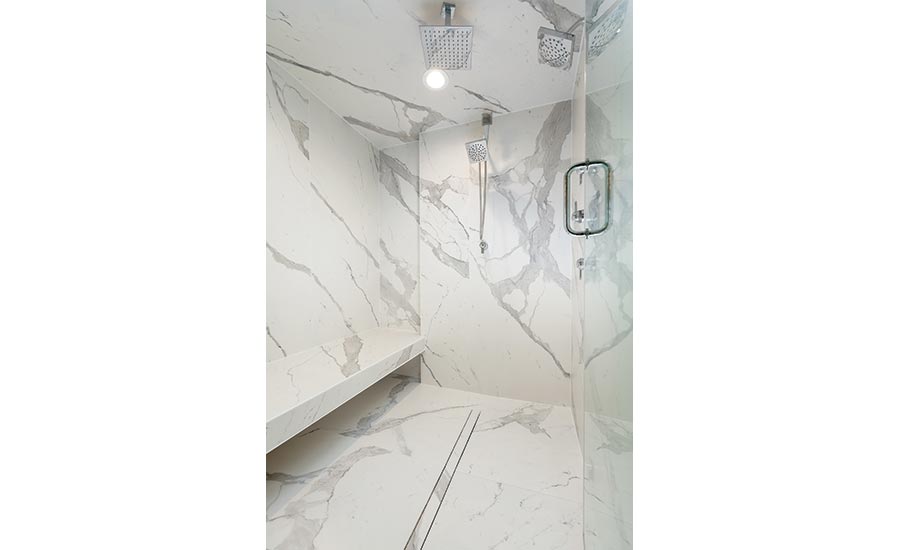
Photo courtesy of Crossville
“For quite some time, the highest request has been for marble-looking colors. However, we’re seeing increased interest in solid colors and colors that do not necessarily imitate stone,” said Ballarin.
“The most popular designs for us continue to be some of the ones that are unique to the lines we carry,” Chitty said. “Oxidized metal from our Oxide collection and metallic texture from the Filo line have continued to be top sellers in the panel category. Statuario and Calacatta looks also continue as top sellers in our panel line.”
Erin Albrecht, principal and executive vice president at J & R Tile, Inc. in San Antonio, TX, agreed with Chitty. “We are seeing an influx of polished Statuario and Calacatta looks, as well as acidic, oxidized metal looks in 1 x 3 meters in a 3.5 mm thickness on wall applications,” she said. “The marble looks are so realistic; it keeps that timeless, classic design perspective most clients lean towards.”
Albrecht added how she sees these products becoming more popular than natural stones and quartz for applications like countertops and walls. “From the tile contractor’s perspective, you can score and snap GPTP with hand tooling for a nominal initial investment to compete with the traditional fabrication shops with millions of dollars in CNC/waterjet equipment,” she said. “Less time, less labor, less cost.”
“Neither quartz nor natural stone can be manufactured in a 6 mm (1/4 inch) thickness. Therefore, the weight of 6-mm-thick porcelain slabs is a fraction of quartz or natural stone,” Ruberti said. “Less mass attached to the walls — easier installation, transportation, handling, with extra benefits such as savings on fabrication and freight.”
“For walls, these products have allowed us to take wall space from less durable options of all sorts. They have allowed us to play in areas where smaller formats with more grout joints would never have had the opportunity to be used,” Chitty added. “While some are embracing our 5.6 mm and even 3+ for countertops, using foam boards as substrates, we believe that our new 12 mm line of materials are much better-suited for the countertop and furniture applications, as they don't require substrates and can be installed directly to the cabinetry like they thicker countertop option rivals.”
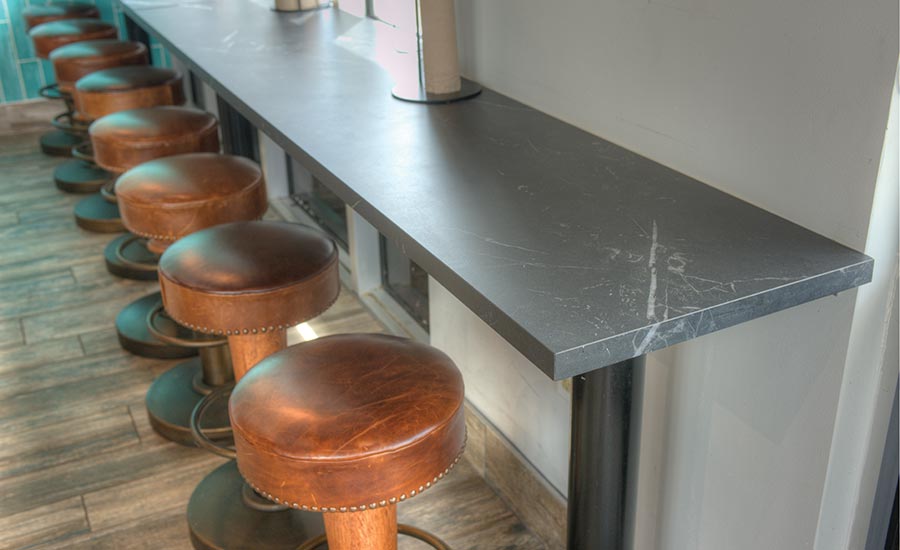
Photo courtesy of Crossville
“International kitchen and bath manufacturers have already included porcelain in their offerings, not only by featuring it in their catalogues, but by showing the material in their showroom or flagship stores,” Ballarin said. “Kitchen and bath manufacturers are well-geared toward the consumers and very often they showcase the full ambient in their showroom by using the porcelain slabs for both horizontal and vertical applications.”
“I think these products will offer designers, specifiers and consumers new and creative options to consider for walls and countertops,” Bettiga added. “The ability to match these materials on a bathroom floor, counter or vanity top, and carry this into the shower will be a big benefit.
“Porcelain performance with marble-look designs also allows for the consideration of these products on kitchen countertops to match kitchen floors,” he went on to say. “In many instances, natural marble will not perform in this same way. Natural and engineered stone will continue to have its place for countertops and walls, but the new technology in porcelain tile is becoming increasingly popular for a lot of reasons.”
Advantages of porcelain
While porcelain may have properties that exceed its natural stone counterparts — such as stain and water resistance — its price point can be cheaper or similar, according to Chitty. “It completely depends on the natural stone,” he explained. “While they can be a much less costly option for some of the marbles and onyx varieties that are out there, the panels that simulate stone looks such as travertine and limestone may or may not be cheaper, but offer exponential advantages, including durability and low porosity, over the natural stone materials they have been designed to replicate.”
“Look at the market, and with the word ‘natural stone,’ you will see a variety of materials such as marble, granite, quartzite, limestone, etc. — each one with different characteristics, looks and prices,” Ballarin said. “Natural stone can be extremely ‘cheap’ and also extremely ‘expensive.’ I would say, in general, for the same type of look, porcelain is more affordable than stone.”
“The GPTP are most definitely more affordable than natural stone and quartz, and offer a totally natural look and a continued, desirable range,” Ruberti added.
Bettiga said the combined price of material and installation are comparable to that of natural stone, while Albrecht begs to differ, stating how GPTP has a much higher cost savings. “I actually have an infographic on this to educate customers. Tile is much more affordable,” she said. “There is also a lifecycle cost associated with maintenance that needs to be factored into the initial purchase price of the stone. The TCNA has done some great flooring comparisons. I believe it’s time to start comparing countertops, facades, cladding, etc.”
There are also no concerns of porcelain sources depleting like the popular marbles in Italy and around the world, which is another benefit. “Large ceramic slabs are prestigious materials, which are definitely competitive and offer the benefit of being available at all times because they are produced on an ongoing basis,” Borelli said.
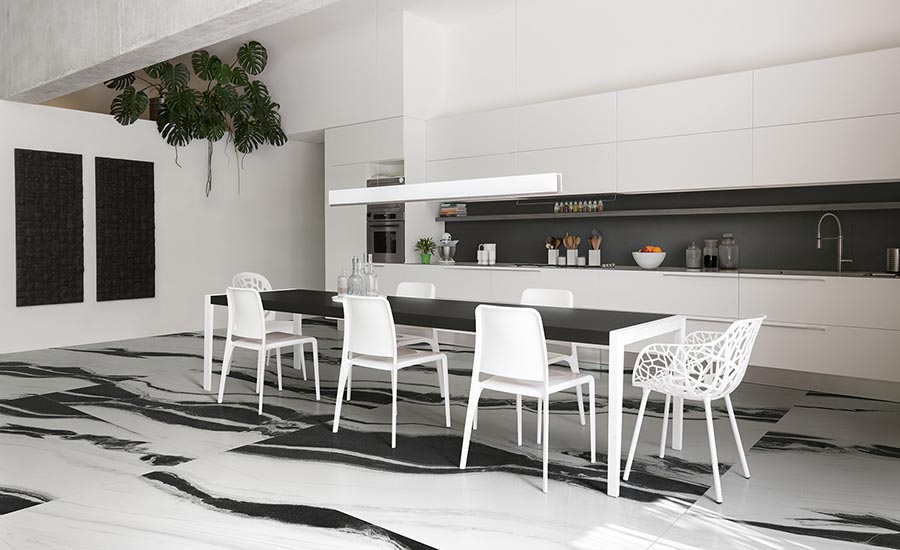
Photo courtesy of Florim
There are various other distinguished benefits to GPTP products, which aren’t seen in other competitive surfacing materials. “The main advantage of these materials is the durability of porcelain, which is far superior then mostly any other surfacing material with which they compete,” Chitty said. “Now, without so many grout joints, these large sheets are taking market share from wallpaper, FRP, painted surfaces and many others in a way smaller-format porcelains never could.”
“Thanks to its technical characteristics, porcelain stoneware offers exceptional performance in terms of health, application, use, cleaning, maintenance and environmental sustainability — all of which make it the safest choice for any kind of application in a residential, commercial or public context, indoors or out,” Macchioni said. “Porcelain stoneware is one of the most hygienic materials, and it’s easy to clean and maintain. It is a durable and unalterable material.
“Porcelain is also versatile; with an infinite variety of sizes and surfaces, it is suitable for any space and ideal for flooring and walls, countertops and tables,” he went on to say. “Moreover, the large format of GPTP removes the quantity and perception of joints, creating an optical effect of widening the space and great graphic cleanliness, harmony and aesthetic realism.”
The ecologically friendly material is also appealing, with no VOCs or harmful toxins. “Porcelain is a healthful material that does not release harmful substances into the environment, and it’s safe because it’s fireproof,” Borelli said.
“It is resistant to liquids and acids, thermal shock and frost,” added Giacomo Caselli, key account manager at Infinity Surfaces, which specializes in the production of large-format slabs. “It has superior mechanical properties.”
The material also has a controlled shade and pattern range, according to Ruberti, which allows ease of use and versatility. “The slabs can be produced in very large quantities with consistent appearance and quality,” he said. “No surprises and no slabs to discard, unlike natural stone.”
“Porcelain tile has very low water absorption and performs extremely well in commercial and residential installations, which allows designers more versatility for where they can choose these materials to be installed,” Bettiga added.
Installation products and methods
Since GPTP has excelled in the tile industry, various tile manufacturers and setting material manufacturers have created installation guidelines and videos to show consumers how to properly install the materials. Most tile manufacturers that produce GPTP have also developed training and certification programs to help installers through the process. The Advanced Certifications for Tile Installers (ACT) program was also created through the combined efforts of six leading organizations in the tile industry — the Ceramic Tile Education Foundation (CTEF), International Masonry Institute (IMI), International Union of Bricklayers and Allied Craftworkers (IUBAC), Tile Contractors' Association of America (TCAA), NTCA and TCNA — to provide a level of consumer confidence for tile installation procedures that exceed ANSI standards and TCNA guidelines for floor and wall applications; ACT-certified installers represent the pinnacle of performance in the tile trade.
The ANSI A108.19 installation standard that was created in 2017 with the help of various industry organizations has also been instrumental in the advancement of GPTP. “From the design and architectural community being able to feel more comfortable that they can spec an installation standard that can guarantee them performance to the industry training that can now be conducted in a consistent way with proven repeatability, the installation standard has given stability to the category that absolutely ensures a solid future for the category for years to come,” Chitty said.
“ANSI A108.19 was critical to develop because the technology is so new that there needed to be clear and specific installation instructions coupled with the introduction of the products,” Bettiga explained. “The entire industry collaborated together to develop this important document. A standard is only effective, however, if it is followed. This is why many tile manufacturers, the NTCA and other labor associations embarked on developing a strong training program with these products. Because these materials are so unique, installation crews should first get proper training before they install them. If they don’t, they run the risk of costly installation error. It is also important to invest in the proper tools to not only install the tiles, but to move them logistically and to place them in the mortar without breaking the material. It is really difficult to successfully install these products without going through the proper training and following the ANSI A108.19 standard.”
“There are currently standards in development to improve language put into place in A108.19,” Albrecht added. “Failures are occurring constantly throughout the U.S. Manufacturers need to be held accountable for meeting the manufacturing specifications of A137.3 and not just sell to any contractor that isn’t qualified. We have come across GPTP materials advertised as meeting A137.3 that would classify as second grade. The larger the community of educated contactors and installers, the better we can work together to make sure manufacturing and distribution is held to the same standards as the installation. We bear the cross in this market and knowledge is definitely power to protect your business.”
Although Albrecht has seen several failures, Chitty said it’s been pretty smooth sailing since Crossville introduced their GPTP products about eight years ago. He also mentioned how a committee is currently in the process of developing a new ANSI standard, A108.20, which will serve as the exterior version of A108.19. “If all goes as planned, our ad-hoc group hopes to be able to present a draft to the ANSI committee by the ANSI meeting scheduled for Coverings 2020,” Chitty said.
In regard to the installation products offered for GPTP, there have been many introductions over the last several years. “Almost every installation material company has designed products specifically for large tile panels and some have designed new adhesive solutions that don’t fall inside A108.19, but offer proprietary solutions worth exploring for the many benefits of time savings, lightweight nature and increased application areas,” Chitty said. “I am confident that in the next six months we will see even more of these proprietary solutions come to market.”
“More are coming every day,” Albrecht said. “It is my belief, and many others, that premixed adhesives increase efficiency and reduce labor costs/time to the extent where all stakeholders in GPTP can be successful. There are distributors willing to give special discounted pricing for Certified Tile Installers, Advanced Certified Installers through the CTEF and NTCA Five Star Contractors. I believe this leadership and stance sends a message needed for relationships and partnerships in our industry. One more reason to earn those accreditations.”
“Tools to move and cut the material are also continuously being developed,” Bettiga added.
The future of GPTP
With GPTP infiltrating all aspects of the architecture and design industries, it has proven its importance in the marketplace. “Porcelain slabs are a pivotal technology and a game changer,” Ruberti said. “The porcelain slabs segment will greatly expand its market share at the expense of other materials. Look at porcelain slabs not just as a wall, floor, countertop or facade, but as a product you can build furnishings with. If you are a designer, your creativity will find in porcelain slabs a material to create new design objects.”
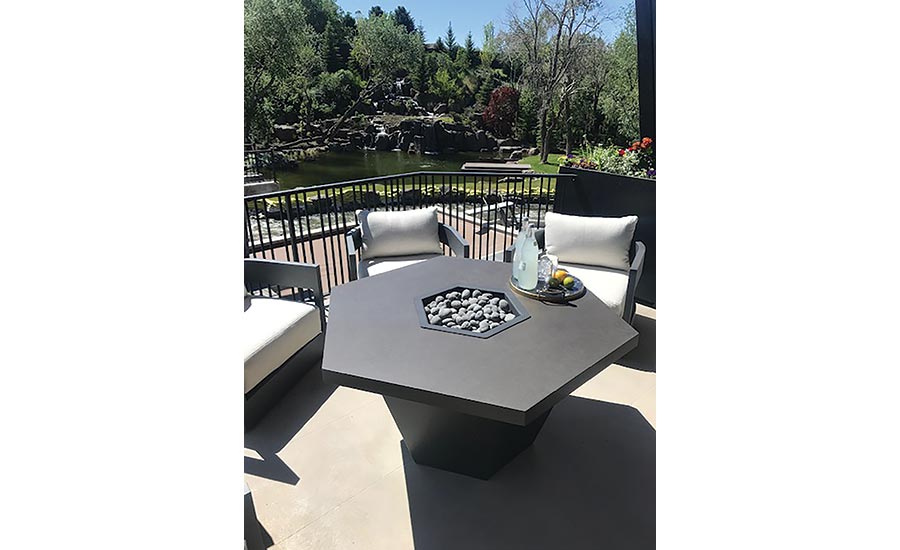
Photo courtesy of Crossville
“Large-format slabs further expand the possibilities for design with ceramics,” Borelli added. “Technological innovation allows us to boast that ceramic is the perfect material for all kinds of applications, from floors to wall coverings, indoors and outdoors.”
“I strongly believe that it won’t be enough to just have a ‘big tile’ in the portfolio to be successful,” Ballarin said. “Dealing with large formats is different than dealing with regular tile, and at this point, is not only a matter of size. There is a completely new way of promoting, installing, fabricating and designing that has to be introduced along with the material itself.”
“These products are the future of the tile industry,” Chitty said. “While 12- x 24-inch tiles and larger, traditional formats will continue to provide the necessary functionality of many commercial and residential installations, which are the bread and butter of the tile industry, panels have allowed us to go into new applications. Now, with the advent of thicker materials for countertops and furniture, the tile industry can expand the places where we can provide material solutions and showcase the benefits of our ceramic materials against lesser beneficial surfacing solutions.”
Looking for a reprint of this article?
From high-res PDFs to custom plaques, order your copy today!






